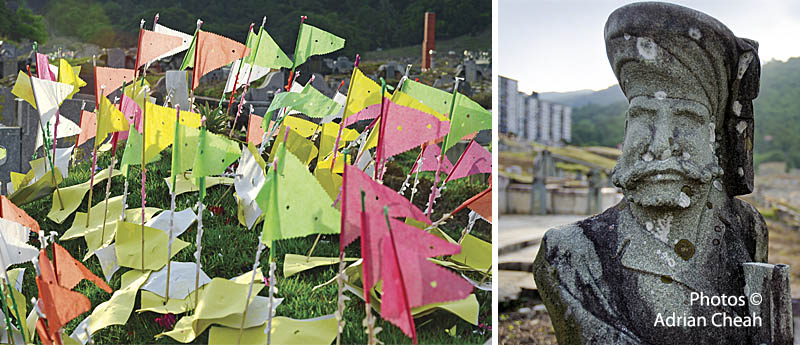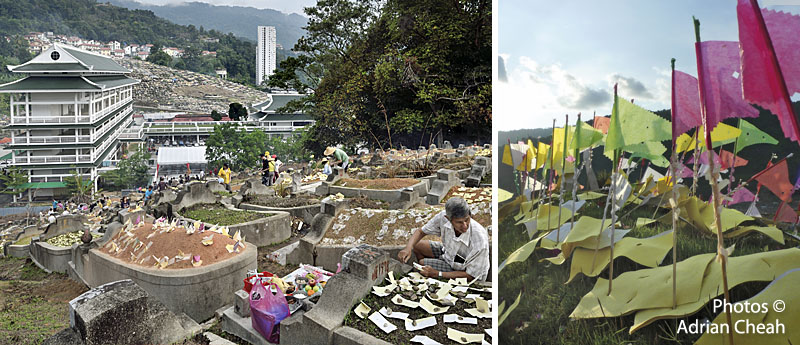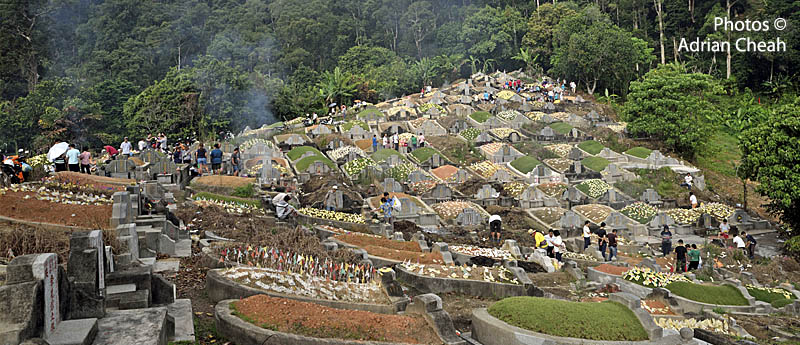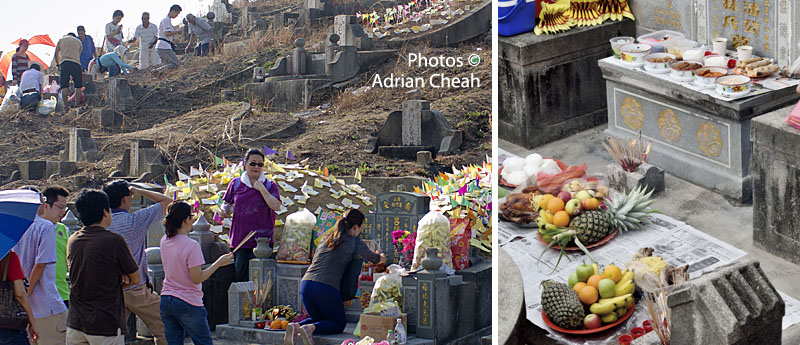Cheng Beng – the Festival of the Tombs

History
The history and practice of Chinese religious and cultural festivals go back a long way, some even beyond the span of written history.
Over the years, the traditions associated with these festivals are handed down from generation to generation within communities, with very little changes introduced. The only difference found in a festival celebrated in two different countries would be cultural ones.
One major event in the Chinese calendar, observed by Chinese communities all over the world is Cheng Beng, also known as Qing Ming, which falls on April 5 every year except on leap years when it falls on April 4.

The following description of such an event, written in the 19th century, shows that little has changed between then and now. Amazingly, even the description of flowers in bloom is similar to the blossoming of the angsana trees (pterocarpus) in Penang, which occurs during Cheng Beng.
One of the most interesting of the Chinese traditions is the Tsing-Ming – "Clear and Bright." It occurs in the spring, and is the time when people visit the graves, on which account it is often called the "Festival of the Tombs".
During this time this lovely season, all nature bursting into life, and the air loaded with the fragrance of spring flowers and blossoms, the hills are filled with visitors, each group seeking out the well-known grave. Offerings of food and paper-money are made to the departed spirit; worship is performed; the place is swept; a few clods of earth are added perhaps to the top of the mound; and a stick is inserted in it, with a small piece of paper attached, to show to the passing observer that this spot has not been forgotten by surviving relatives.
These visits to the hills are not always made on the same day, but about this time, sooner or later.
The wherefore of ancestral offerings

Because the Chinese fervently believed that the spirits of ancestors looked after the family, they will go to great lengths to honour them. This day of honouring – cheng beng – would be observed as a time of obeisance, remembrance and veneration for departed ancestors and immediate family members. Making a special effort to visit the graves and columbariums of departed blood relations also underscores the time-honoured Asian tradition of respect for elders as well as filial piety.
As with other festivals of great import, Chinese from around the country will take time off from work and make special trips to the burial ground of departed relatives. For parents who passed away less than two years ago, prayers are performed on the actual day of Cheng Beng. This custom must be observed for three years. After this period, relatives can visit graves 10 days before and after the actual date of Cheng Beng.
Preparations before Cheng Beng
Preparation for Cheng Beng starts a few weeks in advance. Household members begin by folding pieces of specially printed paper into the shape of a gold ingot called "yuan bao". These are available from the many shops selling prayer items in Penang.

Next, a trip is made to shops (like those in Kimberley Street) selling day-to-day and luxury items made from paper. These are either manufactured here in Penang or imported from China. They include clothes (even the kebaya), footwear, cars, refrigerators, spectacles for reading and sun protection, cameras, deckchairs, video games, karaoke sets, hi-tech phones with digital cameras and internet, water heaters, whole roast pigs, gift hampers containing various 'herbs' and traditional 'health supplements', designer apparel and bungalow homes replete with swimming pool, gardens, guard and maid.

Prices vary from affordable to exorbitant, for example, RM1 for the kebaya, RM2.50 for a pair of clogs, RM10 for medicinal herbs, RM20 for the roast pig and presentation tray and RM90 for the bungalows.
For the convenience of customers, browsing time has been reduced thanks to full colour catalogues of paper items from China. All a customer needs to do is sit down, browse and indicate the items to be purchased.
The choice of items that are available every year is in some ways dependent on current trends. The appearance of high tech gadgets and DVD movies, for example, is a recent phenomenon. The latter is not terribly popular with older folk, as they worry that the departed relative may not know how to operate such items.

The one item which has not changed much over the years is the hell banknotes, which are must-buy items along with other paper products.
All the items bought for the deceased are then placed in a trunk or chest which is also made of paper. After sealing it, the name of the deceased and the date of death are written on two pieces of yellow paper and on the trunk. The yellow papers are glued over the chest one over the other like a cross.

The name written on the yellow papers serves the same purpose as a name and address written on an envelope – to ensure that the gifts reach the correct recipient.
The trip to the cemetery

Families get up quite early on the day the visit takes place. This serves two purposes: one is the time needed for preparing foodstuffs like roasted meats, rice, small 'entrées' and sweetmeats. Two, it helps beat the horrendous traffic jams that always occur in major cemeteries like those in Paya Terubong, Batu Gantong and United Hokkien Cemetery. Other important items to bring are Chinese rice wine, assorted eating and drinking utensils, and some spades and machetes to clean the gravesite.
For those who have no time to cook, according to Madam Hong, you can buy pre-packed vegetarian meals consisting of three vegetables, three helpings of rice, three cups, three chopsticks and three spoons for about RM15.

Most Chinese cemeteries are located on hill slopes (which makes for excellent feng shui), relatives of the deceased visiting the gravesite refer to their activity as "pai or bai san" which means "to pray at the mountain" or "hung san" which means "walk along the mountain." Climbing uphill laden with all the things requires some stamina, so sharing the load among family members is a must.
Before any ancestral offering can be made, the gravesite must first be cleaned spick and span. The women of the household begin by scraping off the candle drippings from the previous year, then arranging the wine cups, bowls and food, and setting up candles and joss sticks. The men will be in charge of the more backbreaking tasks like weeding, chopping small trees and clearing the debris.

Before any offerings can be made to the departed, the guardian of the gravesite must first be appeased with the lighting of candles and joss sticks, and the serving of fruits, cakes or biscuits. The guardian is represented by a small structure sitting on the front of the gravesite towards the right.
Prayers begin after everything has been set up. A piece of paper representing money, called kai chin is placed on top of the headstone and held in place with a small weight. Other pieces of kai chin are spread around the gravesite. Family members call out the name of the deceased and invite him to partake in the small feast. Cups of wine are then gently emptied over the headstone.

After the humble repast, the chest of goodies is set ablaze in front of the headstone, and the name of the deceased summoned again to claim the burnt offerings. At the same time, pieces of kai chin are thrown into the fire to distract other less fortunate ghosts from stealing the paper gifts. Family members must stoke the burning heap every so often to ensure that everything is burnt to ashes because whatever is unburnt won't reach the deceased. Imagine receiving half a shirt, or part of a car!

In Penang, pineapples, representing good luck (the Hokkien for pineapple is "ong lai", which has the same meaning as luck comes) are placed on top of the headstone.
Whether or not one believes that the gifts actually reach the intended recipient is a matter of faith. An interesting story told by a Penang aunty described how a large paper item being carried behind a motorbike fell off and got squashed by a passing vehicle. Undeterred by the damage, the relatives went ahead and burnt the paper offerings. That night, the deceased appeared in a dream of one of the relatives demanding to know why his gift was damaged!
Before leaving, a member of the family must seek the approval of the departed before leaving. This is done by dropping the two pieces of wooden kidney-shaped oracle blocks. If both pieces land on the ground heads or bottoms up, it is permissible to leave. If the pieces are mismatched, it means the opposite. Upon returning home, family members must wash their hands and faces with water scented with pomelo leaves to prevent bringing in any bad luck from the graveyard into the house.
---------------------------------------------------------
Written by Raja Abdul Razak. Photographed by Adrian Cheah
© All rights reserved.
Note: Note: Razak wrote this story in 2006. Prices listed in the story would likely be significantly higher today. It is informative to compare and note the differences.
Updated 26 March 2019